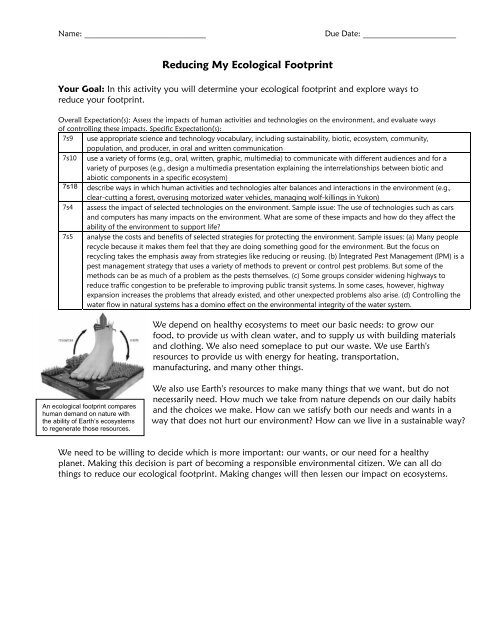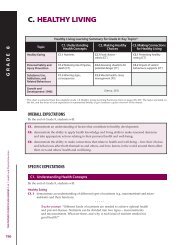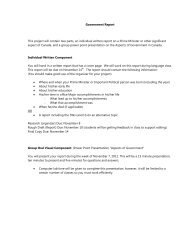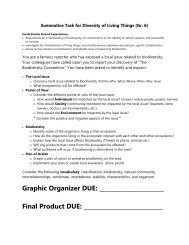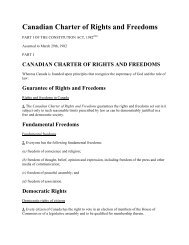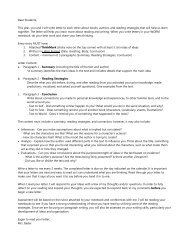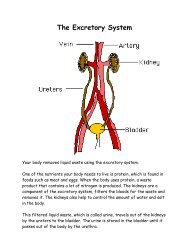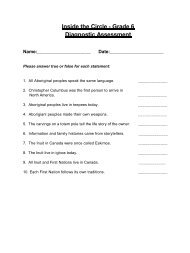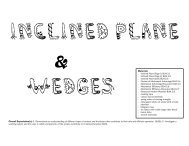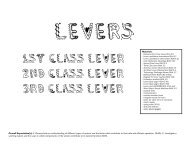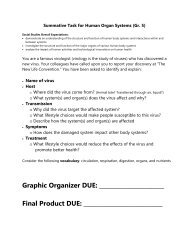Reducing My Ecological Footprint
Reducing My Ecological Footprint
Reducing My Ecological Footprint
You also want an ePaper? Increase the reach of your titles
YUMPU automatically turns print PDFs into web optimized ePapers that Google loves.
Name: ______________________________ Due Date: _______________________<br />
<strong>Reducing</strong> <strong>My</strong> <strong>Ecological</strong> <strong>Footprint</strong><br />
Your Goal: In this activity you will determine your ecological footprint and explore ways to<br />
reduce your footprint.<br />
Overall Expectation(s): Assess the impacts of human activities and technologies on the environment, and evaluate ways<br />
of controlling these impacts. Specific Expectation(s):<br />
7s9 use appropriate science and technology vocabulary, including sustainability, biotic, ecosystem, community,<br />
population, and producer, in oral and written communication<br />
7s10 use a variety of forms (e.g., oral, written, graphic, multimedia) to communicate with different audiences and for a<br />
variety of purposes (e.g., design a multimedia presentation explaining the interrelationships between biotic and<br />
abiotic components in a specific ecosystem)<br />
7s18 describe ways in which human activities and technologies alter balances and interactions in the environment (e.g.,<br />
clear-cutting a forest, overusing motorized water vehicles, managing wolf-killings in Yukon)<br />
7s4 assess the impact of selected technologies on the environment. Sample issue: The use of technologies such as cars<br />
and computers has many impacts on the environment. What are some of these impacts and how do they affect the<br />
ability of the environment to support life?<br />
7s5 analyse the costs and benefits of selected strategies for protecting the environment. Sample issues: (a) Many people<br />
recycle because it makes them feel that they are doing something good for the environment. But the focus on<br />
recycling takes the emphasis away from strategies like reducing or reusing. (b) Integrated Pest Management (IPM) is a<br />
pest management strategy that uses a variety of methods to prevent or control pest problems. But some of the<br />
methods can be as much of a problem as the pests themselves. (c) Some groups consider widening highways to<br />
reduce traffic congestion to be preferable to improving public transit systems. In some cases, however, highway<br />
expansion increases the problems that already existed, and other unexpected problems also arise. (d) Controlling the<br />
water flow in natural systems has a domino effect on the environmental integrity of the water system.<br />
An ecological footprint compares<br />
human demand on nature with<br />
the ability of Earth’s ecosystems<br />
to regenerate those resources.<br />
We depend on healthy ecosystems to meet our basic needs: to grow our<br />
food, to provide us with clean water, and to supply us with building materials<br />
and clothing. We also need someplace to put our waste. We use Earth's<br />
resources to provide us with energy for heating, transportation,<br />
manufacturing, and many other things.<br />
We also use Earth's resources to make many things that we want, but do not<br />
necessarily need. How much we take from nature depends on our daily habits<br />
and the choices we make. How can we satisfy both our needs and wants in a<br />
way that does not hurt our environment? How can we live in a sustainable way?<br />
We need to be willing to decide which is more important: our wants, or our need for a healthy<br />
planet. Making this decision is part of becoming a responsible environmental citizen. We can all do<br />
things to reduce our ecological footprint. Making changes will then lessen our impact on ecosystems.
Name: ______________________________ Due Date: _______________________<br />
Part A – <strong>My</strong> <strong>Ecological</strong> <strong>Footprint</strong><br />
Method<br />
1. Go to http://www.zerofootprintkids.com to determine your ecological footprint.<br />
2. Start by clicking on “Transportation.” This will take you through all the categories of an<br />
ecological footprint.<br />
3. After you have answered all of the questions, you will come to a summary page that<br />
informs you of your ecological footprint.<br />
4. Locate the Carbon category of your footprint. Record the results of your footprint in a table.<br />
(What you use, What you throw away, Home and School, What you use, and Transportation)<br />
Example: Title<br />
Carbon <strong>Footprint</strong> Tonnes of CO2 per year<br />
Transportation<br />
What You Eat<br />
Part B – Graph my <strong>Ecological</strong> <strong>Footprint</strong><br />
1. Create a graph to represent the components of the Carbon <strong>Footprint</strong><br />
Bar Graph Rubric (Part B)<br />
Level 1 Level 2 Level 3 Level 4<br />
Knowledge and Understanding - Knowledge of content (ie/ able to translate information from table into bar graph display,<br />
also completes title, labels, legend, and scale)<br />
Demonstrates limited Demonstrates some Demonstrates considerable Demonstrates considerable<br />
knowledge of content knowledge of content knowledge of content knowledge of content<br />
Communication – Expression and organization of ideas and mathematical thinking using oral, visual, and written forms<br />
(ie/ legend and scale accurately reflect the information on their bar graph; )<br />
Expresses and organizes Expresses and organizes Expresses and organizes Expresses and organizes<br />
mathematical thinking with mathematical thinking with mathematical thinking with mathematical thinking with a<br />
limited effectiveness some effectiveness considerable effectiveness high degree of effectiveness<br />
Application – Making connections within and between various contexts<br />
(ie/ Is the relationship statement true?, does the statement accurately reflect eh data from the graph)<br />
Makes connections within Makes connections within Makes connections within Makes connections within<br />
and between various and between various and between various and between various contexts<br />
contexts with limited contexts with some contexts with considerable with a high degree of<br />
effectiveness<br />
effectiveness<br />
effectiveness<br />
effectiveness
Name: ______________________________ Due Date: _______________________<br />
Part C – Reduce my <strong>Ecological</strong> <strong>Footprint</strong><br />
1. Create a list of ten practical things that you can do to reduce the size of your Carbon footprint.<br />
2. Compare your results with others in your group and with the average Canadian.<br />
Transportation measures the greenhouse gas impacts of your car, public and school bus, airplane<br />
travel and the land converted to make road for you to travel on.<br />
What you eat measures the carbon dioxide, land, and water, required to grow and transport the food<br />
you eat, as well as the waste generated by eating ion fast food restaurants or bringing your lunch to<br />
school in a disposable bag every day.<br />
Home and School measures the carbon dioxide emissions from the energy you use to heat your home<br />
and provide you with hot water. It also measures the land your building currently occupies, the amount<br />
of water you use, and the waste from your paper use.<br />
What you use measures the carbon dioxide emissions from the energy used to run appliances in your<br />
home – fridge, stove, dishwasher, washer, dryer, computer, cell phone, TVs, and DVDs,<br />
What you throw away measures the land required to dispose of your household garbage and the<br />
volume of greenhouse gasses released. It includes wasteful activities such as leaving the lights/water on<br />
and the environmental impact of these activities.<br />
Part D – Expository Writing Piece<br />
Your Goal: Compose an Expository writing piece that explains assess the impacts of your<br />
activities and technologies on the environment, and evaluates ways of controlling these impacts.<br />
1. Some of the ways of reducing your footprint are harder to accomplish than others. Select<br />
three ways that would be easy/ difficult for you to do and explain why. Consider:<br />
Preserving, Conserving, and Restoring Ecosystems<br />
2. Use the data from your Carbon footprint and your list of ways to reduce the size of your<br />
Carbon footprint to create an Expository writing piece. It should include the following:<br />
a. Title<br />
b. Paragraph 1 – The argument (thesis) plus you view (re: ecological footprints)<br />
i. Details about your footprint and 3 main ways to reduce it)<br />
c. Paragraph 2 – The first argument plus some supporting evidence<br />
d. Paragraph 3 – The second argument plus some supporting evidence<br />
e. Paragraph 4 – The third argument plus some supporting evidence<br />
f. Paragraph 5 – Repeat thesis, repeat arguments, concluding statement.<br />
i. Consider: How might the adults in your life score on this? Explain. Is there<br />
one thing that your entire class could commit to doing that would lessen<br />
your ecological footprint?<br />
Part E – Steps to Success – Best Foot Forward - Reduce your <strong>Footprint</strong><br />
1. Select one of the ways you chose to reduce your Carbon footprint.<br />
2. Trace around your foot onto a piece of white paper.<br />
3. On one side write your name in a creative way.<br />
4. On the other side of the footprint write the way you chose to reduce your Carbon footprint.<br />
i.e. I will walk, bike, or take public transit whenever possible.<br />
I will keep thermostat relatively low in winter and ease up on the air conditioning in summer.<br />
5. Add pictures, colour or any creative art to their footprint.<br />
Cut out your footprint.
Name: ______________________________ Due Date: _______________________<br />
<strong>Reducing</strong> <strong>My</strong> <strong>Ecological</strong> <strong>Footprint</strong> Rubric (Part D)<br />
1<br />
Knowledge and Understanding<br />
2 3 4<br />
Has a limited<br />
understanding of the<br />
impact of human activities<br />
and technologies on the<br />
environment.<br />
Thinking and Investigation<br />
Evaluates few of<br />
preserving, conserving, or<br />
restoring these impacts.<br />
Communication<br />
Student uses vocabulary<br />
and terminology of the<br />
discipline with limited<br />
effectiveness<br />
Application<br />
Did not reduced an<br />
element of their <strong>Ecological</strong><br />
<strong>Footprint</strong><br />
Expository Writing Checklist<br />
Has some understanding<br />
of the impact of human<br />
activities and<br />
technologies on the<br />
environment.<br />
Evaluates some ways of<br />
preserving, conserving,<br />
or restoring these<br />
impacts.<br />
Student uses vocabulary<br />
and terminology of the<br />
discipline with some<br />
effectiveness<br />
Reduced one element of<br />
their <strong>Ecological</strong><br />
<strong>Footprint</strong><br />
Has a considerable<br />
understanding of the impact<br />
of human activities and<br />
technologies on the<br />
environment.<br />
Evaluates ways of preserving,<br />
conserving, or restoring these<br />
impacts.<br />
Student uses vocabulary and<br />
terminology of the discipline<br />
with considerable<br />
effectiveness<br />
Reduced one or more<br />
elements of their <strong>Ecological</strong><br />
<strong>Footprint</strong><br />
Content<br />
Title is interesting and appropriate.<br />
<strong>My</strong> report uses 5 paragraphs<br />
Paragraph 1 states my thesis and point of view.<br />
Paragraph 1 states 3 main arguments<br />
Paragraph 2 states my 1st argument and contains related information.<br />
Paragraph 3 states my 2 nd argument and contains related information.<br />
Paragraph 4 states my 3 rd argument and contains related information.<br />
Paragraph 5 restates thesis, point of view and restates my 3 main arguments.<br />
Details are logically developed and specific.<br />
Ending leaves the reader with a clear understanding.<br />
Style and Organization<br />
Format is clear and easy to read.<br />
Conventions<br />
Information is easy to read, with clearly marked divisions.<br />
Sentences are complete.<br />
Punctuation is appropriate.<br />
Has a high degree of<br />
understanding of the impact of<br />
human activities and<br />
technologies on the<br />
environment.<br />
Evaluates several of<br />
preserving, conserving, and<br />
restoring these impacts.<br />
Student uses vocabulary and<br />
terminology of the discipline<br />
with a high degree of<br />
effectiveness<br />
Reduced one or more element<br />
and assisted others to reduce<br />
their <strong>Ecological</strong> <strong>Footprint</strong>.<br />
Met Not Yet Met


